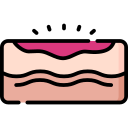Does the wound need cleansing?
- Only cleanse if there is visible debris on the wound bed that needs removed.
- Use warm potable tap water or warmed sterile solutions if immunocompromised such as saline 0.9%.
- PHMB if infected, colonised.
test announcement

Social care workers in care homes and care at home services will not carry out full wound assessments. However, this tool will help you to describe a wound to nursing staff and other clinical colleagues so that appropriate action can be taken.
This chart is provided by Healthcare Improvement Scotland. The National Association of Tissue Viability Nurse Specialists NATVNS (Scotland) examined this resource in 2019. It is due for review.
The visual guide can be accessed here.
This guide presumes that Standard Infection Control Precautions (SICPs) are applied at all times when providing healthcare when there is a risk of exposure to blood, other body fluids, secretions or excretions (except sweat), non-intact skin or mucous membranes.
Does the wound need cleansing?
A. What tissue type and levels of exudate does the wound have?
B. Select secondary dressing if required.
Document in wound chart
A wound chart must be completed for every patient/client with a wound.
Points to remember:
© Healthcare Improvement Scotland 2021
Published February 2021
This document is licensed under the Creative Commons Attribution-Noncommercial-NoDerivatives 4.0 International Licence. This allows for the copy and redistribution of this document as long as Healthcare Improvement Scotland is fully acknowledged and given credit. The material must not be remixed, transformed or built upon in any way. To view a copy of this licence, visit https://creativecommons.org/licenses/by-nc-nd/4.0/
www.healthcareimprovementscotland.org